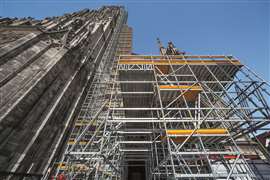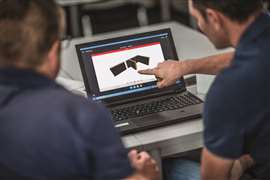Falsework and formwork: Is technology the competitive edge to winning new business?
18 October 2023
Falsework and formwork specialists are focusing on digitaliisation and sustainability, and tech is the competitive advantage to winning new business, reports Katherine Weir.
The adoption of falsework and formwork is essential in the construction of concrete buildings and structures. Engineers need to ensure the most efficient use of concrete as projects worldwide become increasingly complex.
 Peri is part of the renovation of the 161.53 m high main tower at Ulm Minster, Germany. Peri UP work platforms and bridging, and 2D and 3D planning, are being used (Photo: Peri)
Peri is part of the renovation of the 161.53 m high main tower at Ulm Minster, Germany. Peri UP work platforms and bridging, and 2D and 3D planning, are being used (Photo: Peri)
Development in this sector is directly tied to the greater use of technology, and the willingness to strive to meet sustainability goals.
UK-based formwork specialist Altrad RMD Kwikform (ARMDK) acknowledges how new technology is impacting all aspects of construction. Neil Hawkins, global technical services director at ARMDK, said, “We have found many ways, especially in engineering, where automation has reduced our timeframes and increased the efficiency, quality, and accuracy of our output.
“Digital solutions contribute to a more inclusive construction process where the flow of information is unhindered, seamlessly enabling everyone involved to view, interrogate, and communicate information and questions about a project.”
Speaking about how different regions worldwide are advancing at different rates, Hawkins says that 3D is reasonably commonplace, delivering many benefits. “The latest digital engineering tools offer realistic 3D visualisations of temporary works on a build,” he explains. “Helping to break down
any communication barriers and ensure transparency across the supply chain for any specified systems and allowing any potential issues to be quickly raised and remedied.”
On the subject of new technology Hawkins added, “Our commitment to explore new technologies such as 3D printing, finite stress analysis, virtual reality, and augmented reality has provided multiple benefits from conception to design and delivery.”
A representative of formwork, scaffolding, and engineering specialist Peri, said, “Digitalisation and innovative formwork methods are two examples that could become extremely relevant in the future. 3D construction printing is another example illustrating the potential of new technology shaping the future of construction.”
Peri’s MESH technology is said to create curved reinforced concrete components without complex special formwork. It is an automated prefabrication process of 3D reinforcement elements that serve as formwork and reinforcement in the construction process.
 ARMDK engineered a complex formwork shutter to construct the fixed buttresses piers within tight cofferdam constraints on the Colne Valley Viaduct, as part of HS2 phase one
ARMDK engineered a complex formwork shutter to construct the fixed buttresses piers within tight cofferdam constraints on the Colne Valley Viaduct, as part of HS2 phase one
Ammar Mirjan, CEO of MESH AG, said, “I think it’s good and necessary that digitisation and automation are now also on the rise in construction. Both will radically change the construction industry: there will be new architectural design options and more freedom of form, and you will be able to build more efficiently and sustainably.”
Benefits of MESH are said to include less waste, and greater freedom of design, with the ability to plan the number of materials required exactly as needed, Peri claims.
Temperature check
Daniel Stadel, head of Peri Digital, says that the company is investigating how construction processes can be ‘supported and accelerated’ through digital technologies. “Sensor technology is used in the in-situ concrete process,” he said.
“Temperature plays a very important role here – the concrete hardens and heats up. With digital recording of the temperature and concrete strength, it is possible to react more quickly, and it might be that formwork can be stripped earlier.
“Sensors can also be used for hydrostatic pressure, which occurs when concrete is poured into the formwork. The customer can monitor the load limit of the formwork and adjust the concreting speed if necessary. For example, if the load limit of the formwork has not yet been reached, the customer can pour faster. If the formwork is at its limit, we ensure through monitoring that the formwork will not be overloaded and burst. This increases the time and cost savings on the construction site.”
In a previous interview with International Construction, Robert Hauser, CEO of Doka spoke about digitisation, sustainability, and safety in the formwork sector.
 Daniel Stadel, Peri Digital, says the company is investigating how construction processes can be ‘ accelerated’ through digital technologies
Daniel Stadel, Peri Digital, says the company is investigating how construction processes can be ‘ accelerated’ through digital technologies
“Measuring data on a job site, like temperature, pressure, positioning, and extracting the data, storing it, and analysing it for our clients is vital,” says Hauser.
“Data is the goal of the future; it is about measuring as much data as we can and then putting intelligence into it. How can you use the data to make better decisions for the construction process? We are focusing and figuring that out together with our clients – exactly what data and information is useful and then adding more and more of those digital solutions to our DokaXact platform.”
In terms of sustainability, the company has completed measuring the carbon footprint for all its products. “We determined the carbon footprint, from sourcing to raw materials, the manufacturing, the usage lifetime of a product right up to decommissioning,” Hauser says.
Doka was selected earlier this year for a specialised formwork solution for HS2 – the rail link project between London and cities throughout the Midlands, northern England, and Scotland in the UK. The company is supplying equipment and expertise to the project to ensure the completion of a ventilation shaft, and said it was ‘particularly crucial’ to casting the shaft’s secondary lining which was backed by a waterproof membrane.
High expectations
For falsework and formwork projects, is there an increasing expectation from clients that a high level of technology will be used? Peri states that its central goal is to support customers to automate and simplify their work processes.
A Peri representative said, “Our portfolio ranges from the initial visualisation of the construction project through to the option of monitoring the final results with pinpoint accuracy. In addition to in-house planning software, the Peri component library for BIM software, and its customer portal, Peri also has sensor technologies for determining material conditions.”
Clients are increasingly looking to technology to cut costs and improve productivity. Digital tools are not only used to help streamline decisions across the supply chain, but they can also play a crucial role in winning tenders.
Hawkins at ARMDK states, “Technology can be a critical differentiator, playing a pivotal role in helping businesses gain a competitive advantage. Early collaboration at the pre-tender stage can reap real rewards. By using digital engineering technology, recommendations on project structures and construction phases can be ascertained.
“Not only do digital engineering tools help hugely with collaboration, but they provide vital opportunities to manage and control costs, while also preventing waste and better controlling risks.”
Safety through visualisation
Formwork and falsework can help to create safer working environments, while also improving the productivity of construction projects.
“
 ARMDK is championing digitisation in its formwork projects with BIM, virtual reality and augmented reality
ARMDK is championing digitisation in its formwork projects with BIM, virtual reality and augmented reality
Modern formwork and falsework systems often have integrated safety features, such as the Ascent-S and Ascent 200 safety screen systems,” says Hawkins at ARMDK. “They provide perimeter edge protection for site operatives, helping to prevent falls from height, sealing in construction debris, and preventing objects from falling.
“Digital tools are also enabling improved health and safety standards and better workforce planning. BIM, for instance, models all components of the construction process. This includes tools, people, resources, materials, and so on, throughout a building’s lifecycle.”
By understanding a project through better visualisation, experts can identify potential hazards before anyone steps on site.
“In addition, digital tools can help illustrate to users how to best assemble, manoeuvre, and dismantle equipment ahead of delivery, or even map out areas of work so that touchpoints can be better controlled,” says Hawkins. “Those on-site can familiarise themselves with the layout and, as a result, improve the site safety.”
Making a positive difference
Germany-based manufacturer of formwork and support systems, Paschal, brought a new sustainable concrete parting compound to the market in June. MOVA-bio fulfills ‘high environmental standards’, is biodegradable, and is suitable for both absorbent and non-absorbent formwork, the company says.
This solvent-free concrete parting compound is for prefabricated, in-situ, or civil engineering, is based on renewable raw materials, and can be used for all formwork systems. The company claims that the compound meets strict requirements on environmental compatibility and is suitable for all sealing types and concrete consistencies.
Paschal says that MOVA-bio produces clean, exposed concrete surfaces that are free of flecks and cavities. Special additives ensure easy dismantling and good corrosion protection, as well as cleanliness of the formwork.

The construction industry is faced with challenges and pressures to become more sustainable, while at the same time delivering projects that are increasingly complex in terms of both design and build.
Hawkins at ARMDK says that processes need to be streamlined to make a positive difference. “Many see the future of construction practices – such as formwork – being built on the use of digital technologies, enhancing the entire process from start to finish while creating more sustainable operations.
“The NBS Sustainable Futures Report 2022 found that over half of respondents said technologies such as BIM make it easier for them to complete sustainability processes and calculations. This is because BIM involves setting out clear information requirements and then following a digital process to ensure that this information is delivered, also helping measure the sustainable outcomes.”
Andreas Mayer, head of group HSEQ & sustainability Peri SE, says that sustainability is nothing new to the company. “For some time now, we have seen an increasing importance of sustainability for our customers, for our employees, and in society, which is why we have set ourselves ambitious goals to further advance sustainability at Peri.”
Data is the future
What is next for the sector? ARMDK is steering its efforts towards wireless monitoring systems and the use of AI.
“New wireless monitoring systems allow more accurate timelines for striking of formwork and falsework, helping with baseline monitoring at the start of the project,” says Hawkins.
“Throughout the temporary works industry, this technology helps retain the stability of crane bases, struts, or retained facades, or the level of strain or load in props.
“The data provided by monitoring sensors gives a real-time picture of the environment or the condition of a structure and can help identify potential problems.”
Hawkins believes that, out of all the new technology available, AI will be the next big development in the sector. “It will be used to assess client 3D models and automate the design of many falsework and formwork solutions,” he says. “We have already taken many of the initial steps required to start venturing into AI such as 3D modelling, automation, and big data. The question is how fast the AI will spread throughout the sector.”
Frank Ilg, head of future products and technologies at Peri SE, says, “Technological change is omnipresent and is something that never ends. We also see developments corresponding to sustainability issues.
“At the same time, it is hard to predict one single development. Therefore, we ask ourselves what the future of the construction industry might look like and have our own department seeking answers to these questions. Some of their past activities already have shown significant results, such as the use of 3D printing in construction.”
CONTÁCTESE CON EL EQUIPO




